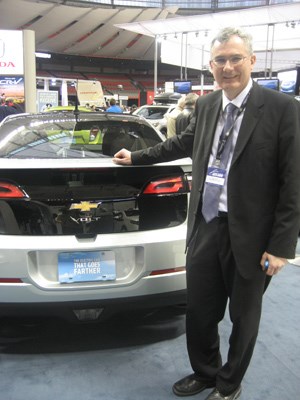Converting to the electrically-charged mode of transportation is a double-edged sword. Its all good, but someone has to pay the piper.
For the well-off, the early adopters, technology buffs and gear-heads, getting in on the first wave of a new standard of vehicle is exciting, challenging and even an attention-seeking mission.
Electric vehicle owners are ostensibly the souped-up Mustang owners of our day. Auto manufacturers receive a ton of free publicity simply by having their cars driven around by intelligent, forward-thinking individuals ready to describe, in minute detail, the benefits of electric, and how much they love it. After all, theyve got to justify their new acquisition.
I took it right between the eyes.
Pulling no punches, electric vehicle owner Jeff Ciachurski fessed up that he paid full price (just over $40,000) for his new Chevrolet Volt (GMVolt.com) from Carter GM in September, 2011.
As chief executive officer for Western Wind Energy Corporation a business involved in the renewable resource industry in California Ciachurski could, hypothetically, have been on the inside track with General Motors.
But alas, though the firm did purchase other electric vehicles for corporate use, the shiny and new black Volt hit this family mans pocketbook square on. But its not all bad news.
I have a home office in Coquitlam, but also a corporate office in downtown Vancouver, said Ciachurski. My return trip is approximately 45 kilometres, and the total expense for that trip in electricity is wait for it 46 cents!
Ciachurski estimates that driving an SUV that distance (his family also owns a hybrid SUV) would cost about $20 in fuel; for a sub-compact, probably $7.
I think this car is awesome. The ride is very fast, its quite smooth and comfortable, too, he said, but of course that doesnt make up for the steep price, not yet anyway. But the rest of its attributes are environmental bliss.
Extolling the virtues of the Chevrolet Volt may be in his job description, but Director of Engineering for GM of Canada, Matt Crossley, is much more than a talking billboard for the car and the company.
Speaking at the Chevrolet Volt exhibit at this years Auto Show in Vancouver, Crossley divulged that he is also a member of GMs Canadian Regional Engineering Centre (CREC) in Oshawa, Ontario. He was quick to point out that Canada did indeed have some input as part of the Volt development team.
Our team handled the vehicles comprehensive diagnostics, so that the vehicle can operate at peak efficiency in all types of weather, Crossley said. We also had input into the navigation system.
The Volt is an extended range electric vehicle. Its not a hybrid, as some may think, said Crossley. The battery will take you anywhere from 40 to 80 kilometres on a full charge, but usually around 60. If you drive a long way and need to go to the gas back-up engine, you can get up to 500 kilometres distance.
The base model includes OnStar navigation; for a small upgrade you can get leather interior, park-assist and rear-view assist and full navigation package.
Were finding that buyers are those whose lifestyle dictates driving 60 kilometres or less a day, and who occasionally do more. And half of new Volt purchasers are female, so its not just the gear-heads who are showing enthusiasm, Crossley said. Even my Dad, after he took a ride with me a few times, loved it, so he bought himself one!
But changing old habits is a challenge. So pioneers like Ciachurski have to pay, that others may follow suit.
I used to drive a big BMW; it was great, but being in the business Im in, I wanted to be part of this social change, said Ciachurski. I decided to take a gamble when I saw that GM had put a lot of science and quality into the product.
Hes logged about 3,500 kilometres so far, and has driven 100k in one day, tops. Eschewing the 240V charging system, he plugs in with the 120V charger at home at the end of the day, but I can also charge at my parking stall downtown at the Hong Kong Bank building, so thats really handy, he said.
In answer to the need for his Volt to kick-in to the gas engine back-up, Ciachurski lays it on the line: I have used probably less than 12 litres since I bought the car. I think the engine has only been needed four times.



